Collaboration with Environmental Protection Administration Taiwan (EPAT)
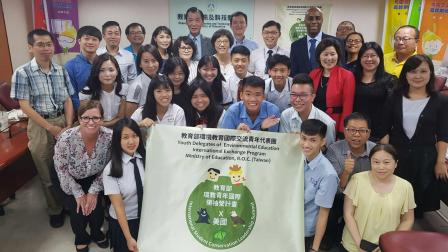 Principal Deputy Assistant Administrator Jane Nishida visits Taiwan’s Ministry of Education to meet participants in the 2018 U.S.-Taiwan Tribal Youth Summit.
Principal Deputy Assistant Administrator Jane Nishida visits Taiwan’s Ministry of Education to meet participants in the 2018 U.S.-Taiwan Tribal Youth Summit. Taiwan is an environmental leader in the Asia Pacific region. EPA established an agreement with the American Institute in Taiwan (AIT) in 1993 and works with the Environmental Protection Administration Taiwan (EPAT) to implement the agreement.
EPA's close partnership with EPAT has now evolved into a robust platform for sharing experience and expertise with each other as well as assisting environmental agencies and partners in the Asia-Pacific, Latin America, and Africa regions. Through this partnership, U.S. and Taiwan environmental authorities have worked to manage the environment and reduce pollution through projects, research, and knowledge exchange.
In 2014, EPA and EPAT officially launched the International Environmental Partnership (IEP), a network of experts from around the world working together to strengthen capacity for addressing environmental challenges. To date, IEP results include:
- expanding mercury monitoring in the Asia Pacific region to harmonize atmospheric mercury monitoring;
- establishing a regional air quality protection program to strengthen air quality management in countries across Asia;
- helping countries explore new ways of managing electronic waste;
- establishing Eco-Campus school partnerships between schools in the U.S. and Taiwan; and
- supporting the Global Environmental Education Partnership, which involves more than ten environmental ministries committed to improving environmental literacy in their home countries.
Explore our work with EPAT:
- Recent Events
- Environmental Priorities
- Key Partners
- Agreements
- Learn More About Taiwan
- International Environmental PartnershipExit
Recent Events
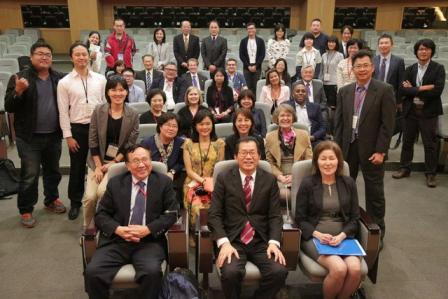 Environmental protection and public health officials and experts met in Taiwan to discuss methods of increasing integration of both sectors to improve policy formation around children’s health issues. (November 2017)
Environmental protection and public health officials and experts met in Taiwan to discuss methods of increasing integration of both sectors to improve policy formation around children’s health issues. (November 2017)- January 2020: The Asia-Pacific Mercury Monitoring Network (APMMN) deployed a rainwater mercury monitor at Palau’s Environmental Quality Board (EQB) in the capital city, Koror. EQB will monitor mercury in rainwater for the first time to understand mercury emissions and exposure on the island. APMMN’s central laboratory in Taiwan collects samples from monitors operating in Vietnam, Indonesia, Philippines, Thailand, Sri Lanka, Nepal, Mongolia, Taiwan, Fiji, and Palau.
- January 2020: The South & Southeast Asia-Air Improvements in the Region (SSEA-AIR) program – led by air experts from U.S. EPA, EPA Taiwan, and Battelle Institute – launched the fourth and final online module designed to explain U.S. EPA’s air quality action planning processes to government officials and experts in Asia. These modules guide air quality planners and policymakers to improve air quality and human health and reduce transboundary air pollution.
- December 2019: A delegation of 15 governmental officials, academics, and private sector professionals associated with the Environmental Protection Administration of Taiwan’s Toxic & Chemical Substances Bureau (TCSB) traveled to the U.S. to improve their domestic peer review process by observing EPA’s Peer Review of the Draft Evaluation sessions for methylene chloride and N-methylpyrrolidone (NMP).
- December 2019: U.S. EPA and EPA Taiwan co-hosted the 9th International E-Waste Management Network Meeting (IEMN) in Bangkok, Thailand to bring government, private sector, and NGOs together to share strategies on the environmentally sound management and recycling of e-waste. The keynote remarks were delivered by Hsu-Ming Yen, Executive Director of EPA Taiwan’s Recycling Fund Management Board and Erik Anderson, First Secretary of U.S. Embassy Bangkok’s Economic Section.
- November 2017: At the kick-off of the Asia-Pacific Children’s Health Symposium in Taipei, Taiwan, Jane Nishida, EPA Principal Deputy Assistant Administrator for International and Tribal Affairs joined Chien-jen Chen, Taiwan Vice President and Ying-Yuan Lee, Minister for Environmental Protection Administration, along with participants from Japan, Korea, Singapore, and Taiwan. Taiwan’s Ambassador for global environmental affairs, Winston Dang, chaired the conference. The new children’s health initiative brings together researchers, policymakers, and other stakeholders to address environmental health risks to children.
- October 2017: Policymakers, experts, and private sector professionals from around the world met at the IEP Circular Economy Global Forum in Taipei, Taiwan to share circular economy (sustainable materials management) approaches to plastics and food reuse and recycling. Discussions with industry representatives included a closed-loop electronics packaging system which is currently saving millions of dollars each year. Other speakers presented on the importance of integrating circular tools in communities and companies to drive down financial and environmental costs associated with waste and redundancy.
Environmental Priorities
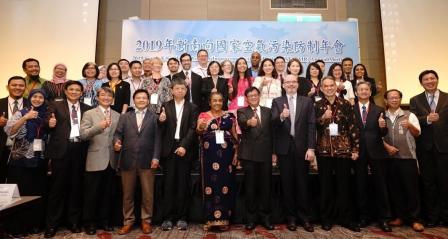 Air quality management officials from nine countries in Asia participate in the South & Southeast Asia-Air Improvements in the Region Annual Workshop in Taipei City in 2019. According to the World Health Organization, EXIT approximately 7 million people died in 2012 as a result of air pollution exposure. To address this challenge, EPA and EPAT have collaborated on air quality protection for nearly twenty years.
Air quality management officials from nine countries in Asia participate in the South & Southeast Asia-Air Improvements in the Region Annual Workshop in Taipei City in 2019. According to the World Health Organization, EXIT approximately 7 million people died in 2012 as a result of air pollution exposure. To address this challenge, EPA and EPAT have collaborated on air quality protection for nearly twenty years. In 2018, EPA and EPA Taiwan launched the South & Southeast Asia-Air Improvements in the Region (SSEA-AIR) program to make measurable reductions to air pollution in Asia Pacific countries. Together EPA and EPA Taiwan have introduced eight Asian countries to this program. In 2019, at the SSEA-AIR Workshop in Taiwan, the partners learned how EPA and EPA Taiwan conduct air quality action planning to achieve results.
Reducing Exposure to Mercury
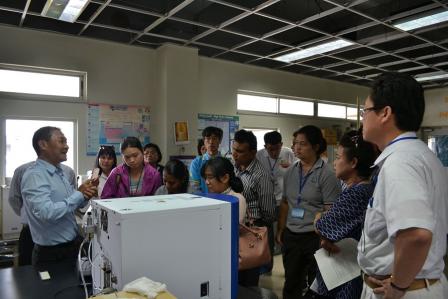 Mercury monitoring officials from North America and Asia received training on rainwater sampling to improve their domestic monitoring practices and more accurately understand mercury deposition.Mercury is a naturally occurring element widely found throughout the environment. Processes such as power generation from coal-fired power plants, incineration of waste, and metal processing emit mercury to the atmosphere. Like many forms of air pollution, mercury transcends national borders. Increasing industrialization has made Asia the main source region of mercury emissions to the global atmosphere.
Mercury monitoring officials from North America and Asia received training on rainwater sampling to improve their domestic monitoring practices and more accurately understand mercury deposition.Mercury is a naturally occurring element widely found throughout the environment. Processes such as power generation from coal-fired power plants, incineration of waste, and metal processing emit mercury to the atmosphere. Like many forms of air pollution, mercury transcends national borders. Increasing industrialization has made Asia the main source region of mercury emissions to the global atmosphere.To address this, EPA partnered with EPAT, the National Atmospheric Deposition Program, and Taiwan’s National Central University to launch the Asia Pacific Mercury Monitoring Network (APMMN) in 2012. APMMN shares information, data, tools, and technologies to expand coordinated mercury monitoring capacity in the Asia-Pacific region; provides training and support to scientists in the region; and develops baseline mercury data useful to regional and global modelers. APMMN seeks to systematically monitor wet deposition and atmospheric concentrations of mercury in a consistent, standardized network of stations throughout the region.
Learn more:
Promoting Environmental Education
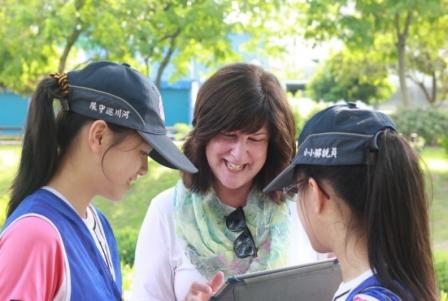 Delegation of US educators visited an elementary school in Tainan as part of the Eco-Campus Partnership Program.
Delegation of US educators visited an elementary school in Tainan as part of the Eco-Campus Partnership Program.EPA collaborates with EPAT to integrate environmental education into all sectors of our societies including businesses, schools, communities, and families. EPA and EPAT coordinate programs such as Eco-Campus Partnership Programs, Kids Making Sense, and the Global Environmental Education Partnership to promote quality environmental education and empower youth around the world to drive positive change in their communities.
Programs include:
- Global Environmental Education Partnership Exit
- U.S. - Taiwan Eco-Campus Partnership Program (National Wildlife Federation)
- Kids Making Sense Exit
Cleaning Up E-waste
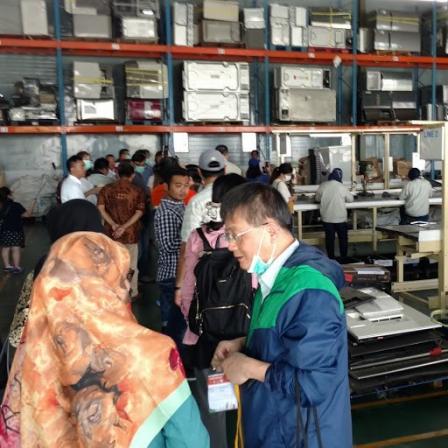 E-waste officials and experts from around the world learned methods of integrating informal recyclers and new mechanisms for funding domestic e-waste programs.Discarded cell phones, tablets, and other electronic devices, commonly called e-waste, can be recycled so that gold, silver, copper, and other valuable materials can be reused. Recycling e-waste not only provides these valuable elements as a useable resource, but also prevents materials from being thrown into landfills, where harmful materials, like lead and mercury, can pollute the environment and endanger human health.
E-waste officials and experts from around the world learned methods of integrating informal recyclers and new mechanisms for funding domestic e-waste programs.Discarded cell phones, tablets, and other electronic devices, commonly called e-waste, can be recycled so that gold, silver, copper, and other valuable materials can be reused. Recycling e-waste not only provides these valuable elements as a useable resource, but also prevents materials from being thrown into landfills, where harmful materials, like lead and mercury, can pollute the environment and endanger human health. EPA and EPAT have collaborated since 2011 to build global capacity for the environmentally sound management of waste electrical and electronic equipment. To support this goal, EPA and EPAT coordinate the International E-Waste Management Network (IEMN). The IEMN enables environmental officials from within and beyond the Asia-Pacific region to exchange information and best practices on e-waste management.
Learn more:
Building Strong Institutions and Legal Structures
 Environmental enforcement inspectors from the U.S., Taiwan, Vietnam, and Thailand exchanged information on crime scene investigation techniques, technologies, and practices to improve their domestic enforcement capabilities.
Environmental enforcement inspectors from the U.S., Taiwan, Vietnam, and Thailand exchanged information on crime scene investigation techniques, technologies, and practices to improve their domestic enforcement capabilities.Strong environmental laws that protect our natural resources and safeguard our health must be complemented by effective enforcement. To establish an enforcement regime that effectively detects, corrects, and deters violations requires thoughtful strategies, well trained inspectors, supporting legal tools, and a fair and just sanction system.
EPA and EPA Taiwan are currently cooperating bilaterally on issues of environmental enforcement. The two organizations are also working together to share new methods and approaches with each other and other partners. For example, EPA shared information with EPAT on waste water continuous emission monitoring systems management and enforcement, river water quality abnormal polluter findings, evidence preservation, CAA, CWA, RCRA cases, litigation, toxicology in enforcement, and water sensor and GMAP technologies, among many other topics. Recently, EPA and EPAT held a joint training to share information on standard practices, crime scene investigation, and new enforcement technologies with investigators from two Southeast Asian countries.
Addressing Contaminated Soil and Groundwater
With rapid economic development, soil and groundwater pollution has become an increasingly serious challenge for many developing countries in Asia. Contaminated sites impact human health, particularly the poor, children, elderly and other vulnerable communities. Cleaning up contaminated sites reduces the impact of pollutants on groundwater sources. This improves ecological systems and the food supply both in Asia and the U.S.
To achieve this, EPA and EPAT experts serve as technical trainers for agencies and institutions across the Asia-Pacific region on the clean-up of contaminated sites, addressing topics such as forced-air remediation, bioremediation and phyto-remediation.
Programs include:
Key Partners
The following links exit the site Exit
- Environmental Protection Administration Taiwan
- American Institute in Taiwan
- Taipei Economic and Cultural Representative's Office
-
North America Association for Environmental Education
-
National Wildlife Federation
-
Agreements
- View the agreement. (PDF) (1 pp, 29 K, About PDF)
